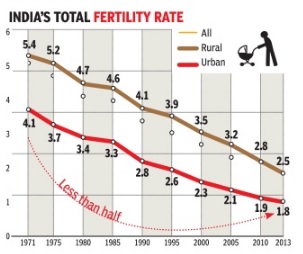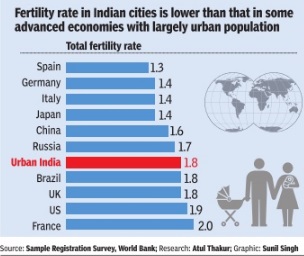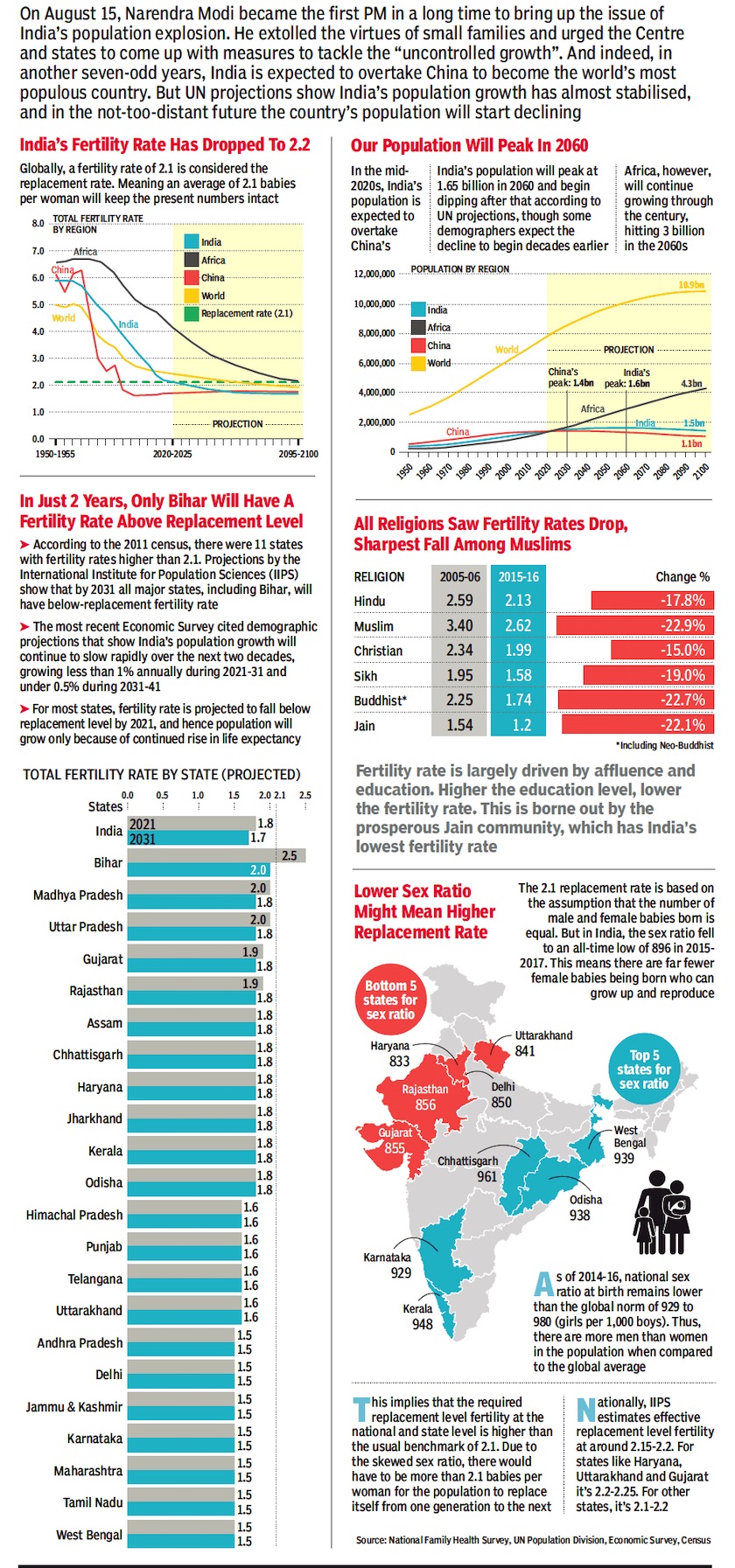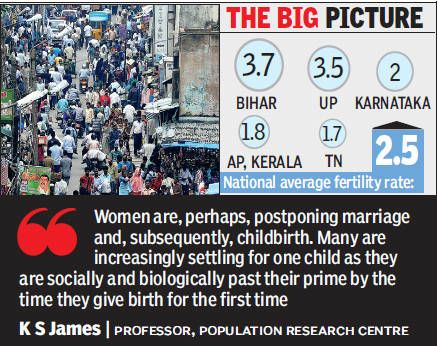Population growth and fertility rate: India
This is a collection of articles archived for the excellence of their content. |
Contents |
In brief
The Times of India, 28 March 2013


Saswati Mukherjee
South India lags national fertility rate, slows population boom
India's burgeoning population appears to be both a problem and an advantage. Very soon, the southern states are likely to stare at an un-Indian situation: a shrinking populace, owing to a sharp dip in the fertility rate of women.
Analyzing the 2011 Census data, the Population Research Centre of the Bangalore-based Institute for Social and Economic Change found that many southern districts, a significant number of them in Karnataka, have recorded fertility rates lower than the national average. The study says turnaround will happen soon.
Half of India's 1.21 billion population comprises women, and the national average fertility rate stands at 2.5, slightly higher than the targeted 2. The theory is simple: two children replace two parents, and the population remains stagnant.
Experts say women in most southern states appear to be settling for one child, pulling down the average fertility rate.
Karnataka's overall fertility rate stands at 2, but there's an interesting variation in the districts. In Udupi, for instance, the fertility rate is 1.2; in Hassan, Mandya and Chikmagalur, it's 1.4; in Dakshina Kannada and Kodagu, it's 1.5. Bangalore, at 1.7, is well below the national average. Some districts, though, have high fertility rates: Bijapur stands at 3, and Bidar at 2.7.
The other South Indian states of Kerala, Andhra Pradesh and Tamil Nadu are in the sub-2 category.
"Women are, perhaps, postponing marriage and, subsequently, childbirth. Many are increasingly settling for one child as they are socially and biologically past their prime by the time they give birth for the first time," said K S James, professor, Population Research Centre, who led the data analysis.
SUDDEN DISARRAY
What happens if the population shrinks? Arresting the spiralling population growth rate has always topped the nation's agenda. Experts, though, beg to differ. A sudden turnaround in population could lead to demographic disarray, they say. "The first result of negative population growth is the number of elderly people goes up and young people comes down. This means there are fewer youngsters to take care of our elderly," said Prof. K S James.
WOMEN MAKE INFORMED CHOICE
Experts say women make an informed choice to have a single child, given the high literacy level in the southern states.
"Often, this is to give the lone child a good quality of life. Keeping in mind the high cost of living, young couples are increasingly settling for one child," said retired ISEC professor KNM Raju.
With both men and women being educated, they make informed decisions. "The woman's decision today is well thought out, and she has her partner's support too," said Raju.
The implication could be quite significant. If both partners in a marriage are themselves from single-child families, the responsibility of taking care of both sets of parents falls on them. "Parents these days are not dependent on their children financially. It's the psychological dependence which will be missed the most," Raju pointed out.
Experts attribute this trend to the southern states being open to change. "It's their willingness to accept social changes that work for them," said Raju.
NORTH-SOUTH DIVIDE
Unlike their southern counterparts, the northern states are showing an increase in fertility rate. The country is evenly poised, with half the country adhering to the national average and below, and the other half exceeding the figure.
Experts point to high awareness and education levels and successful family planning programmes in the southern states for low fertility rate figures. Rajasthan, Uttar Pradesh, Madhya Pradesh and Bihar, though, have the highest fertility rates in the country, experts say.
Fertility rate
1950-2020

India vis-à-vis Bangladesh, China, Iran, Pakistan, Sri Lanka and First World countries, 1950-2020.
From: July 2, 2020: The Times of India
See graphic:
India’s total fertility rate, 1950-2020
India vis-à-vis Bangladesh, China, Iran, Pakistan, Sri Lanka and First World countries, 1950-2020.
1950-2019: India, Africa, China, World

i) Total fertility rate; and
ii) Population growth.
Total fertility rate in India:
a) religion-wise, 2005-16.
b) state-wise, 2011.
The sex ration in India, 2017.
From: August 17, 2019: The Times of India
See graphic, ‘ India, Africa, China, World, 1950-2019:
i) Total fertility rate; and
ii) Population growth.
Total fertility rate in India:
a) religion-wise, 2005-16.
b) state-wise, 2011.
The sex ration in India, 2017. ’
China, South Asia: trends, 1995-2015
The Times of India, Apr 18 2017


20 years ago India added an Australia to its population every year
Twenty years ago, India added the equivalent of Australia's population to the number of Indians every year, while China added a Cameroon. Both countries have been able to bring about a significant reduction in the population growth rate and absolute increase in population since then. But China has done much better, almost halving the number of people it adds to its population
Education and TFR
2013-2018
Ambika Pandit, July 1, 2020: The Times of India
As the total fertility rate (TFR) reflects a decline from 5.2 in 1971 to 2.2 in 2018, the Sample Registration System Statistical Report 2018 highlights how not just age but education levels of women have had a direct impact on fertility. At the national level, TFR for illiterate women in 2018 was 3. This is much higher than the literate group, which has a TFR of 2.1 and has seen a decline with the increase in the level of education.
TFR indicates the average number of children expected to be born to a woman. Going by the data, a rural woman (having a TFR of 2.4) at the national level would have about one child more than an urban woman (having a TFR of 1.7) on an average.
Fertility rate, region-wise
In urban India lower than in US, Oz, France
The Times of India, May 14 2016

Fertility rate in India's cities lower than in US, Oz, France
Atul Thakur
For most people, the gene ral perception about In dia is of a country sitting on a ticking population bomb.This notion, however, seems to be somewhat misplaced, at least in the context of the country's urban population where the fertility rate -the number of children born per woman -has fallen to levels lower even than those in countries like the US, France, Australia and New Zealand.
Data from the Sample Re gistration Survey (SRS) shows that since 2006, total fertility rate (TFR) in urban areas has touched two children per woman and from 2010, has fallen below that level.That means there aren't enough children born in Indian cities to replace the existing population of their parents.For advanced economies, this `replacement rate' is generally estimated at an average of 2.1. Because of the higher infant mortality rate (IMR) in developing countries, the replacement level fertility rate would be slightly higher and so Indian cities seems to have touched the point where the population would start declining in the absence of migration from rural areas.
Is this an alarming trend?
Experts don't think so: “2.1 is more like a synthetic number.During fertility transition, the total fertility could go below 2.1 and stabilise in a decade or two“, says population expert Purushottam M Kulkarni, who recently retired from JNU. Ravinder Kaur, professor of sociology and social anthropology at IIT Delhi, points out a similar pattern of low fertility across Asia and in Catholic southern Europe.
“Although the IMR is substantially high compared to western countries, it is not as alarming as it used to be and there is a general confidence in the population that the chances of a child's survival are higher compared to the past decades and hence fertility is low,“ added Kulkarni. Data shows that in 1971, the infant mortality rate was 82 (per 1000 births) and total fertility rate was 4.1for urban India.
Though the rural fertility rate of 2.5 is higher, it too has witnessed a steep decline over the years. In 1971, the rural fertility rate was 5.4, nearly double its present level. Incidentally , in 1952, India became the first country in the world to launch a family planning programme. The sustained government campaign, better access to healthcare facilities, higher female literacy and more participation of women in the workforce have all worked in lowering fertility rates in cities. Many couples prefer one child, although this is not the general norm.
“The fewer children preference allows the middle class to rise up the social ladder by investing more in them is gendered with preference of sons over daughters. Sons bring dowries and investing in their education helps families move up socially ,“ says Kaur. Professor Kulkarni, however, points out that there are regional differences as southern states have lower fertility and better sex ratios.
2017: a little education is worse than none
Rema Nagarajan, August 12, 2019: The Times of India

From: Rema Nagarajan, August 12, 2019: The Times of India

From: Rema Nagarajan, August 12, 2019: The Times of India
The higher the educational level of a woman, the lower the total number of children she will have, according to conventional wisdom. However, recently released official data from 2017 on the total fertility rate (TFR) or the average number of children born to a woman over her lifetime shows the connection may be more complex. For one, the culture of a state might be a greater determinant of fertility, with illiterate rural women in Tamil Nadu having a lower fertility rate than urban graduates in Uttar Pradesh.
There’s a consistent pattern across states of illiterate women and those with no formal education having lower fertility rates than those with below primary level education. It raises the question: does little education lead to higher TFR? Is a threshold number of years of education required to reduce fertility? Experts say this pattern – referred to as “inverted-J” — has been observed in other countries. However, they caution that this pattern in 2017 data, and to some extent in 2016 data, can’t be taken as significant unless it stays for 4-5 years.
‘State culture has greater influence than education’
The pattern tends to be more pronounced in highfertility populations, say experts. However, in the 2017 data, this pattern held true even in states with lower fertility. For instance, in Bihar, a high fertility state, the TFR of women who have not completed primary schooling is 4.4 compared to 3.7 for illiterate women. Similarly, in Odisha with an overall low fertility rate of just 1.9, the TFR of illiterate women was 2 compared to a TFR of 3.6-3.5 among those with primary level schooling or below. At the all-India level, the TFR for women with below primary education was 3.1 compared to 2.9 for illiterate women and 2.4 for those without formal education.
Dr KS James, director of the International Institute for Population Studies in Mumbai, explained that this inverted-J pattern in fertility is seen not only in education levels but also in income levels. “Usually there is an inverse relationship between education or income and fertility, but it has been observed that fertility could go up with a slight increase in education or income level. But eventually, fertility declines with higher levels of education,” said Dr James. However, Prof PM Kulkarni, a renowned demographer and population expert, pointed out that the pattern was clearly discernible only in the 2017 data. “It could be because the number of illiterates in all states has been falling and so the sample size for illiterates might be small, leading to errors. At this stage, I wouldn’t call it a trend. We need to see it for three or four years,” said Prof Kulkarni.
Dr James pointed out that the culture of a state or geography had greater influence than education or socio-economic characteristics on fertility while explaining why even urban graduates in high-fertility states like UP or Chhattisgarh had fertility rates of 2.2 and 2 respectively compared to illiterate rural women in states like Maharashtra and West Bengal with fertility rates of 1.3 and 1.4 respectively.
2005-17: saturation point reached?
July 5, 2019: The Times of India

From: July 5, 2019: The Times of India
With India set for a sharp slowdown in population in the next two decades, the Economic Survey calls for optimising education infrastructure, if necessary by merging schools, as the number of school-going children is estimated to decline by 18.4% between 2021 and 2041.
This will need to be balanced by a increase in health infrastructure with an expanded focus on geriatric care as demand for hospital beds is set to go up in view of the growing healthy life expectancy for both men and women at 60 years of age. As of 2016, population in the 5-14 years agegroup, which roughly corresponds to the number of elementary school-going children, has already begun declining across all major states except Jammu & Kashmir.
Population projections suggest that this trend will continue through 2041 and the size of the 5-14 years population will drop sharply in Himachal Pradesh, Uttarakhand, Tamil Nadu, Maharashtra, Punjab, Andhra Pradesh and Karnataka by 2041. It will also decline in the laggard states such as Bihar, Uttar Pradesh, Rajasthan and Madhya Pradesh.
“In light of the projected decline in elementary schoolgoing children, the number of schools per capita will rise significantly in India across all major states even if no more schools are added,” it is stated in the survey report.
It said that states such as Himachal Pradesh, Uttarakhand, Andhra Pradesh and MP have more than 40% of elementary schools with fewer than 50 students. Similar trends exist in Chhattisgarh, Assam and Odisha with large number of schools per capita and small school size. “The number of elementary schools with less than 50 students has increased over the past decade across all major states except Delhi,” it is stated. “The time may soon come in many states to consolidate or merge elementary schools in order to keep them viable. Schools located within 1-3 kms radius of each other can be chosen for this purpose to ensure no significant change in access”. The recommendations come with a word of caution that this is not about reducing investment in elementary education, but is an argument for shifting policy emphasis from quantity towards quality and efficiency of education.
While school going population will decline, the ageing population with enhanced life expectancy is going to put pressure on the health infrastructure. It is pointed that if India’s hospital facilities remain at current levels, rising population over the next two decades will sharply reduce the per capita availability of hospital beds in India across all major states. For states in the advanced stage of demographic transition, however, the rapidly changing age structure will mean that the type of health care services will have to adapt towards greater provision of geriatric care.
2012-17: Both sex ratio, fertility rate decline
Rema Nagarajan, July 16, 2019: The Times of India

i) Sex ratio
ii) Fertility rate
From: Rema Nagarajan, July 16, 2019: The Times of India
India’s sex ratio at birth (SRB) — the number of female babies born for every 1,000 male babies — fell to an all-time low of 896 in 2015-2017. This would translate into approximately 117 lakh girls missing in the country in a span of three years. Five large states — Uttar Pradesh, Rajasthan, Bihar, Maharashtra and Gujarat — with poor sex ratios at birth account for about two thirds of these missing girls.
Uttar Pradesh alone accounts for about 34.5 lakh missing girls or about 30% of the total, followed by Rajasthan with 14 lakh, Bihar with about 11.6 lakh and Maharashtra and Gujarat, each with about 10 lakh girls missing in the three years.
While the sex ratio continues to decline despite government efforts, India’s total fertility rate — the number of kids likely to be born to a woman — which was stuck at 2.3 from 2013 onwards, fell to 2.2 in 2017, close to the replacement level fertility of 2.1.
Replacement fertility is the level at which a population can replace itself from one generation to the next without growing or declining and it is estimated at 2.1 children per woman. Below this level, the population starts shrinking. Nine states, including some of the least developed, have fertility levels higher than 2.1, though two of these, Gujarat and Haryana, are at 2.2. Only in Uttar Pradesh and Bihar are women on average likely to have three or more children.
Of 13 states with below replacement level fertility, Delhi has the lowest at 1.5. Barring Rajasthan, Bihar and Uttar Pradesh, urban populations of all states have less than replacement level fertility. In rural areas, MP, UP and Bihar have a fertility rate of three or more. India’s total fertility rate has fallen steadily from 3.2 in 1998 with the most dramatic improvement in the southern states where it fell from about 4 in the 1970s to the current level of 1.6 or 1.7.
The pressure to have smaller families in a society that prefers boys, along with access to sex determination methods and methods of getting rid of female babies could be leading to an alarmingly skewed sex ratio. Though some of the states with the worst SRB, such as Haryana, Gujarat and Punjab, have shown gradual improvement over the years, they are yet to regain the levels of the 1990s. Also, these are mostly states with smaller populations and fewer births. So, the improvement here is more than offset by declining SRB in populous states like Uttar Pradesh, Bihar and Madhya Pradesh with a huge number of births, leading to India’s overall SRB continuing to fall.
Moreover, many states that had earlier recorded high SRBs such as Kerala and Odisha have witnessed a steep decline. Kerala had an SRB of 948, second only to Chhattisgarh, but this has plummeted 26 points from 974 in 2012-14. In Odisha, the fall from 956 in 2011-13 to 929 by 2015-2017 is an even sharper 27 points.
Mother’s education and fertility rates
2001-2011
The Times of India, May 03 2016

Well-educated moms have half the no. of kids that illiterates do: Census data
Subodh Varma With more girls reaching higher levels of education, the average number of children born to them after they get married is falling, Census 2011 data released on Friday shows. India had nearly 340 million married women and the average number of children was 3.3, down from 3.8 in 2001 and 4.3 in 1991.
But hidden in this average figure is a wide range between an illiterate mother and a welleducated one. Mothers who were deprived of education in their early life and have remained illiterate had 3.8 children on average. At the other extreme, mothers with a graduate degree or above had just 1.9 children. That's half the number of children compared to illiterate mothers.
The average number of children is calculated by counting the number of children ever born to women in the 45-49 age group, which is the end of their reproductive age and thus represents the total children they can have.
While the spread of education is widening with each passing year, school drop out rates are still unconscionably high among girls. An idea of this is gained from enrolment data for 2014-15 put out under the District Information System for Education (DISE), which shows that there were around 13 million girls enrolled in Class 1 but the number went down by 58% to 5.4 million in Class 12. With this kind of massive dropout, it will take many years for the overall fertility rates to decline substantially more. Census data shows that between the two ex tremes of illiterate and graduate+ mothers, there is a continuum as the educational level increases, the average number of children goes down. Mothers who have not studied beyond class 8 (middle school) have three children on an average, those who dropped out between middle and high school had 2.8 children and those who had studied between class 10 and graduation restricted their children to 2.3.
The rates of decline between 1991 and 2001 were 14% for mothers who studied up to middle school but between 2001 and 2011 this decline was more at 18%. It was a similar situation for other educational levels.
Is it just education of mothers that is causing this decline? Experts say that it is a key factor but accompanied by a set of other circum stances that go with mothers' education. More educated women are likely to be from better income households and are also likely to be married to more educated men.So, according to them everything put together is helping.
The Census data also shows that there are still nearly 96 million illiterate married women who are in the child bearing age, that is, 15-49 years. And there also are about 16 million married women in the same age group that have not studied beyond primary level. Presumably, they are yet untouched by the wider trend of having less children.
